Separation anxiety or normal puppy behavior?
October 23, 2021 2021-11-11 5:27Normal puppy behavior is often confused for separation anxiety, and vice versa, because they can appear similar on the surface. Separation anxiety is an intense feeling of distress felt by dogs when they are apart from their owners. It has several distinctive symptoms, many of which overlap with immature puppy behaviors.
In order to understand whether your pup’s behaviors are normal or symptoms of separation anxiety, let’s take a look at each of the symptoms individually, and when they are something to worry about vs when they are not.
Table of Contents
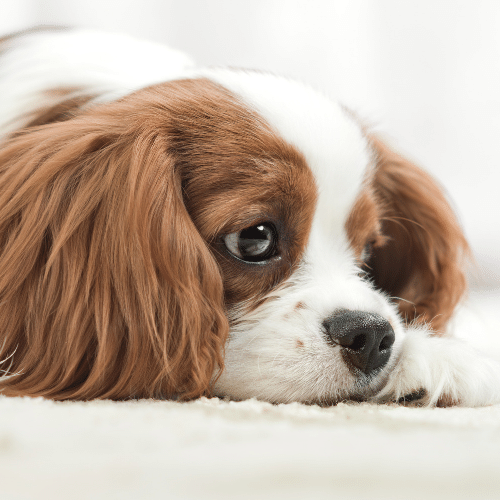
Barking, whining, & howling
One of the most common symptoms of separation anxiety in dogs is barking, whining, and howling whenever their owners leave the house. This is simply their way of expressing distress.
Puppies may also cry a little when you leave them alone for the first time, and this is understandable! The difference is, pups without separation anxiety but will quickly settle down, whereas dogs with separation anxiety will persist until you return.
Destructive behaviors
Another common symptom of separation anxiety is destructive behavior. Many dogs suffering from separation anxiety will destroy their possessions, such as toys and beds, as well as household furniture and objects, some will even hurt themselves by obsessively licking, scratching, and biting their limbs or tails out of distress and frustration.
However, a little destructiveness is fairly normal puppy behavior, especially if your pup is teething. Teething is a natural process that all baby mammals go through, in which their baby or milk teeth fall out, and their adult teeth grow in. It can be extremely uncomfortable, and the only way pups can relieve their discomfort is by chewing. And because they haven’t learned the rules yet – they will chew anything and everything – until it falls to pieces!
So, if your pup is teething-age (under the age of 6-8 months), so long as they aren’t harming themselves or only doing it when you leave the house, it’s most likely not anxiety-related.
To discourage your pup from chewing your furniture, try a furniture spray or teething gel. Furniture sprays contain natural, harmless puppy repellents such as citrus and vinegar that your pup won’t like the smell of. Most pet stores also sell teething gels that can be applied to your puppy’s gums to relieve discomfort – as well as the need to chew.
It’s highly recommended that owners train their puppies on what is and isn’t theirs to chew, as well. You can do this by redirecting “naughty” chewing to toys, and praising them when they get it right. To put a stop to unwanted chewing, use negative signals such as crossing your arms and turning away from your pup. This indicates to them that you are not happy – and puppies don’t like being ignored!
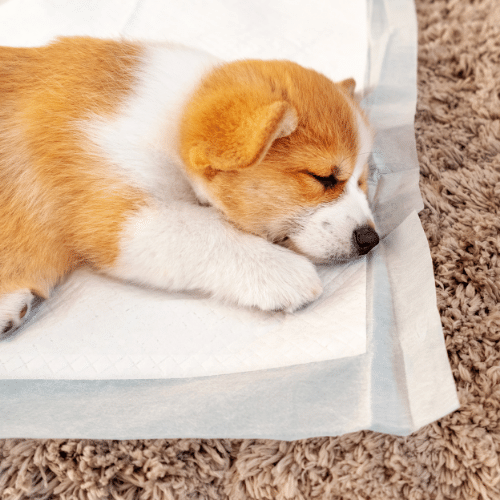
Going to the toilet indoors
Another sign of separation anxiety in dogs is going to the toilet indoors – even in housebroken dogs. This happens because they become so anxious that their bodily functions are accelerated and they just can’t hold it until you return.
However, this is also normal in young puppies. All un-housetrained pets will go to the toilet indoors until they have learned to go outside. Toilet training a puppy can take 2-3 months and requires lots of consistency!
Whenever your pup needs to go, you should usher them outside, and praise them when they get it right. It’s much easier if you feed your dog and take them outdoors around the same times each day, but when accidents do happen, don’t punish them – it’s not their fault!
Trying to escape
Another behavior often seen in dogs with separation anxiety is trying to escape the home after you leave. They do this because they want to find you, but it can be very dangerous, as they may hurt themselves trying to get out, or get lost, taken, or hurt should they be successful.
However, puppies are extremely curious creatures. They want to explore everything – and this is normal. Therefore, it’s not strange for them to try and dig under the floor or climb on top of window sills. So, you must make sure your home is puppy-proof and safe, and supervise your pup at all times.
When you leave the house, leave your untrained pup contained in a small, secure, safe place in the home, and unless they are only trying to escape when you’re not there or are very distressed when doing so, it’s likely not anxiety-related behavior.
Other behaviors
Other signs of separation anxiety include repetitive behaviors like pacing, as well as shaking, stomach upsets and drooling. No puppies should be displaying these behaviors, and they are almost certainly signs of anxiety – unless they develop suddenly, in which case they may be a sign that your dog has eaten something they shouldn’t.
That said, if these behaviors are not accompanied by other symptoms of separation anxiety, or they happen when you are at home, they could be being caused by another type of stress. Other causes of stress and anxiety in puppies include traumas such as dog attacks and scary storms, phobias, illnesses, big life changes or changes in schedule, and somebody in the family becoming ill, moving away, or dying.
What causes separation anxiety in puppies?
Puppies can get separation anxiety when they lack independence, so it’s important to build their confidence gradually with proper separation training.
Most young pups have never really spent time alone; they probably spent the first two months of their lives with their mothers and siblings before they went home with you, and so being by themselves is brand new territory. Everything is new, exciting, and scary, but you are the one constant in their lives, so your pup may cling to you for protection and become anxious when you are not there.
Understimulation can also contribute to separation anxiety. When puppies aren’t getting enough exercise, mental stimulation, or social interaction, they can become bored, lonely, and get a build-up of excess energy, which can quickly turn into frustration and anxiety.
Any puppy can get separation anxiety, but it’s more likely to occur in breeds with high-maintenance personalities like Australian Shepherds and Border Collies.
It can also be a result of illness or trauma, both of which, understandably, can make dogs afraid of being alone. It’s important to address any underlying illnesses by taking your pup to the vets, and trauma can be helped with lots of TLC, a stable routine, and positive association training with triggers, or avoiding them altogether.
How to do separation training with puppies
If your puppy is destructive when you are apart, don’t punish them, they’re not trying to be “bad” or “naughty”. This will just increase their anxiety and ruin your relationship. It could even encourage their behavior because they are desperate for your attention. It’s far more effective to show them that destructive behaviors don’t get any attention from you, but to stop (or prevent) separation anxiety altogether, you need to do some separation training with your pup.
First of all, try leaving the house for a short amount of time, like 5-10 minutes. Then, the next day, go out for a little longer. Keep doing this and adding a little more time each day to reassure your pup that you’ll always come back.
Say goodbye to them when you leave, but don’t make a big thing of it. Just calmly say goodbye, pat them on the head, and leave. Then, when you return, if your pup has not been destructive, give them a big cuddle. This lets them know that whenever you go out, there is always something to look forward to later.
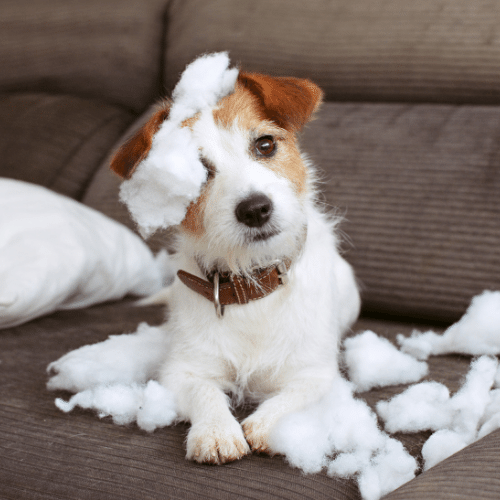
If your pup has been destructive in the past, give them lots of rewards when they stop to reassure them that they’re getting it right. If you do this every day, you’ll see a difference in your pup’s symptoms within weeks.
You should also try to make some positive associations with spending time alone. Encourage solo play with puzzle toys, feeders, and treat dispensers. Then, when you go out, give your pup their favorite toy as you leave. This will give them something fun to do while you’re apart and show them that time alone can be rewarding.
It’s also smart to desensitize your puppy to anything that may indicate separation. For example, if there is something that you normally do before you leave, like grabbing your keys, do it, and then go back to whatever you were doing before. This shows them that your actions are nothing to worry about and should get rid of some of that anticipatory anxiety.
If your puppy’s anxiety is severe, try some anti-anxiety products like plug-in diffusers and herbal supplements. They’re completely natural and harmless and are known to reduce stress levels significantly.
Understimulation & separation anxiety in puppies
As mentioned above, under-stimulation can be a contributing factor in canine separation anxiety, but it’s important not to overexercise your pup as this can damage their developing bones. So – how can we make sure our pups get enough stimulation without overworking them?
Puppies typically need 5 minutes of exercise per month of their age twice a day until they are adults. So, a 4-month-old puppy needs 20 minutes of exercise twice a day, a 5-month-old pup needs 25 minutes twice a day, etc. However, some pups have so much energy that this can seem like it just isn’t enough to tire them out.
To make walks as stimulating as possible, try to go to different places do different activities, like hiking, running, swimming, and playing games of fetch with different toys. To avoid loneliness, involve your pup in your family life as much as possible and interact with as many friendly people and dogs on walks as you can.
Mental stimulation through play is arguably the best way to reduce anxiety in dogs. Treasure hunt and hide and seek are ideal games for pups who have mastered the basics of training. To play hide and seek, ask them to sit and stay while you hide somewhere in the house, then, call them to come and find you. To play treasure hunt, follow the same rules as hide and seek but hide your pup’s favorite toy or some treats instead.
With younger puppies, instinct-based games like fetch, chase, and tug are always firm favorites, but you can turn almost anything into a game with youngsters. Anything to do with visuals, sounds, movements, and water is great fun for them.
In fact, games and toys that stimulate the senses are ideal for pups that need a good mental workout. Puzzle toys are ideal for grown-up dogs in need of some enrichment, but they might be a little too advanced for younger pups. However, you can try simple treat-dispenser balls, slow feeders, and snuffle mats, as they work just as well.
Chewing is a great stress-buster, too. So be sure to provide your pup with hardy chew toys and treats. Frozen carrots are perfect for both teething pups and heavy chewers alike, as they are healthy, tasty, and hardy, but soft enough for baby teeth and even soothe aching gums.
If you’ve taught your pup all of their basic training, try teaching them some fun tricks using our dog tricks course to challenge their minds even further. Popular tricks include wave, roll over, spin, handstand, and leg weaving.
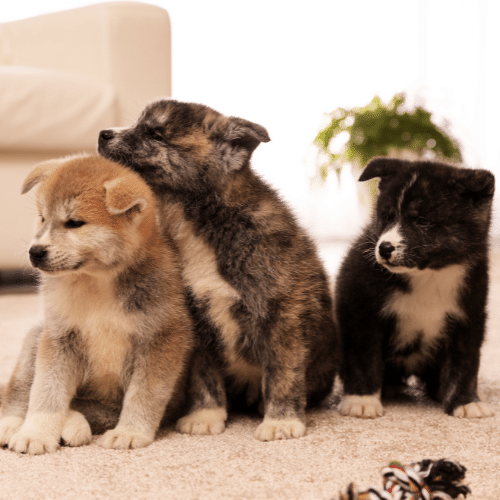
How long can you leave your puppy alone?
To avoid accidents, you shouldn’t leave your pup for more than one hour per month of their age. This generally applies until they are 6 months old – because their bladders work by the same rules!
After that, Britain’s leading dog charity Dog’s Trust recommends that you don’t leave a pup or dog over 6 months old alone for more than four hours at once. If you need to leave your pup alone for longer than that, it’s best to ask somebody you trust to look after them.
If you will be away from the home regularly, you need to be sure that a puppy is right for you. See if it’s possible to include your dog in your long-term arrangements, and if it’s not, you could hire a dog sitter or enquire about a local doggy daycare center.
Should you leave your puppy crated?
Untrained puppies should always be left confined to a small, secure, safe area of the home using a crate or dog gate, with enough room to stand up, lie down, and move about. This protects them from hurting themselves and having accidents around the home.
Once they understand the rules, you can start to leave them unconfined. This is different for every dog, but for most people, they find that they can leave their dog uncrated between 6-12 months of age, but it can take longer.
When you leave the house for long periods of time, you should make sure your pup has access to their bed, some drinking water, and preferably, some toys. Although, if your pup is teething or just a heavy chewer, don’t leave them with anything that is likely to break or anything containing stuffing.
Can separation anxiety hurt puppies?
If your puppy has developed separation anxiety, it could cause them to hurt themselves through their destructive behaviors. However, the anxiety itself shouldn’t hurt them, although, as mentioned above, it can cause stomach upsets. It could also make any existing conditions worse, but this is unlikely in puppies.
It also shouldn’t affect their personality. You may have heard that anxiety can lead to aggressive behavior, and over time, it can. However, this is extreme and relatively rare. So long as your pup’s separation anxiety is identified and worked on, there is no reason that this should happen to your pup.
Bottom line
If your puppy cries or rips up their bed the first time you leave the house, don’t panic! It doesn’t necessarily mean that they have separation anxiety. All puppies are noisy and destructive!
All young pups will also be a little anxious being left alone at first, and this is only natural. However, it should go away by itself. Separation anxiety, on the other hand, is a serious problem that requires some help, and will only get worse without it.
It is a good idea to practice separation training with your pup, whether they appear to be anxious or not, as it promotes a healthy relationship with separation. Monitor their behavior and if you think your pup has a problem, try to create some positive associations and consult a professional trainer if necessary.
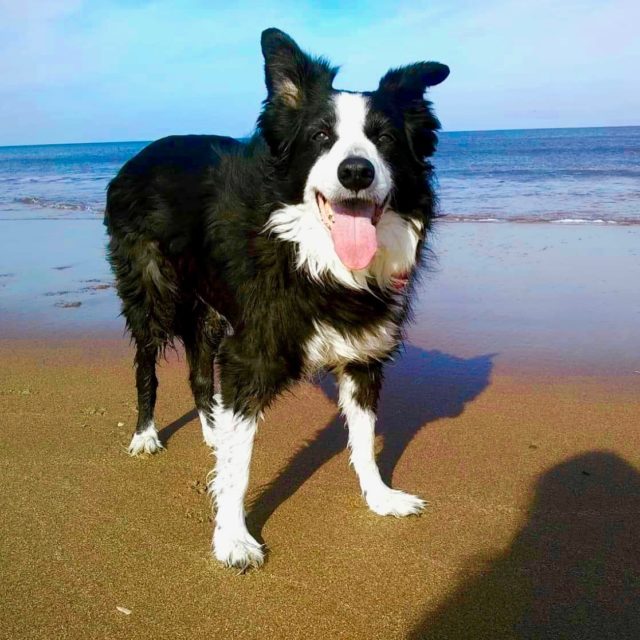
Laura
Writer and Border Collie Mom
Laura is a dog-lover with an animal-related degree and plenty of hands on experience. She is passionate about dog health & welfare and wants to arm owners with all of the essential info they need!

